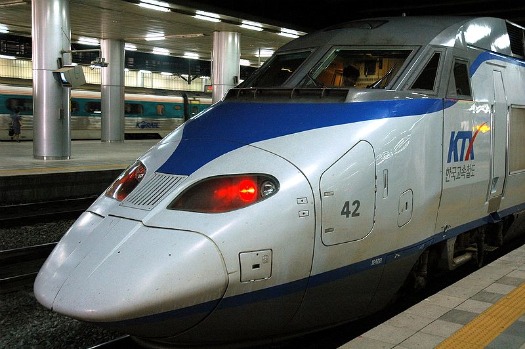Korea’s train system is expansive, reasonably priced, and is easy to navigate even if you can’t read or speak Korean. Automated ticket machines are available in every station, and trains run to most anywhere you want to go. They can get very crowded during holidays and weekends. After 3 1/2 years of traveling Korea, these are six secrets of traveling the trains I’d like to pass onto you.
Secret #1: There are three classes of trains: the first-class KTX, capable of 300kph), the second class Saemaeul (which means ‘new town’ in Korean and celebrates a 1970’s movement to develop local communities), and the third-class Mugunghwa (which means the Rose of Sharon, Korea’s national flower). After three-plus years of traveling Korea, I’m happy to say the Mugunghwa-class trains are the most comfortable by far. Wait, what? They have wide, reclining seats, and many feature recently redone seat recovering. The trains themselves might be a bit older, but the interiors have kept up with the times. Both they and the Saemaeul trains feature ‘cafe cars’ – a reminder that the KTX has speed (and business passengers) in mind. They’re also about half the price of the first-class KTX, and might be the only type of train to stop at your destination. The only catch is their relative slowness – it can take twice as long to reach your destination.
Secret #2: If traveling on a standing room ticket, any seat that`s available is yours until / unless the ticket holder shows up. The locals know this, and as such will aggressively push to claim empty seats as they do on the subway. Even if they have the same standing-room ticket as yours, some might “claim” to have the seat. Ask to see their ticket, then apologize if you`re in their space. Otherwise, stand your ground. There’s nothing a train official can do, except encourage you to yield your seat to an older Korean (that’s Confucianism at its finest).
Secret #3: Some train cars have room for two wheelchairs in the front of the car. These are excellent places to grab some real estate on the floor if you have a standing-room-only ticket. Spread out a bit to claim a little more real estate – it makes a world of difference on a crowded train. It goes without saying, of course, that a truly handicapped person should never be hindered from their rightful seat. Stay classy, people.
Secret #4: Making a trip to Seoul but the trains are sold out? Look beyond the main train stations (Seoul Station or Yongsan Station are the two largest) and try Haengsin (northern Seoul, connected to line 6), Yeongdeungpo (western Seoul, connected to line 1) Cheongnyangni (eastern Seoul, connected to line 1), Suwon (south of Seoul, connected to line 1), or even Cheonan (even further south of Seoul, connected to line 1). It may be a bit further away from your destination, but it`ll get you back to the Seoul area even if the rest of the trains are full – if necessary, the subway can get you around to your final destination.
Secret #5: Power, baby! The Saemaeul and Mugunghwa trains both feature electric outlets at the front and back of most cars. They’re free to use, although you’ll need to ensure you have the proper connectors to fit the Korean plug. The KTX-Sancheon trains also feature plugs for every pair of seats, but not on normal KTX trains. You do get tray tables and a magazine on the KTX, though.
Secret #6: If you can possibly avoid it, try not to travel back to Seoul on a Sunday night. If you know you’re going to or can’t help it, book your ticket as far ahead as possible. Once you’ve reached your destination is a good time as well. As you might expect, these are the trains most likely to sell out ahead of time – especially during a big festival weekend or some beautiful weather. You don’t typically need to buy your tickets ahead of time the rest of the time, unless you’re headed to a major festival.
Photo Credit: Creative Commons Attribution-Share Alike 3.0 Unported License – based on a work at commons.wikimedia.org
More on this Guest Blogger
Chris Backe is the writer and photographer behind Chris in South Korea. His blog covers Korean travel and life in Korea, and answers readers questions about Korea. Since March 2008, he’s visited at least one new place, event, destination, or performance around Korea every single week. For more of his writings, or to get some ideas for your future Korean trip, check out his website.


Hey there ! Thank you for writing this article – I just got to Seoul and it gave me some extremely useful pointers (electricity outlets on mugunghwa trains ?! Fantastic. )